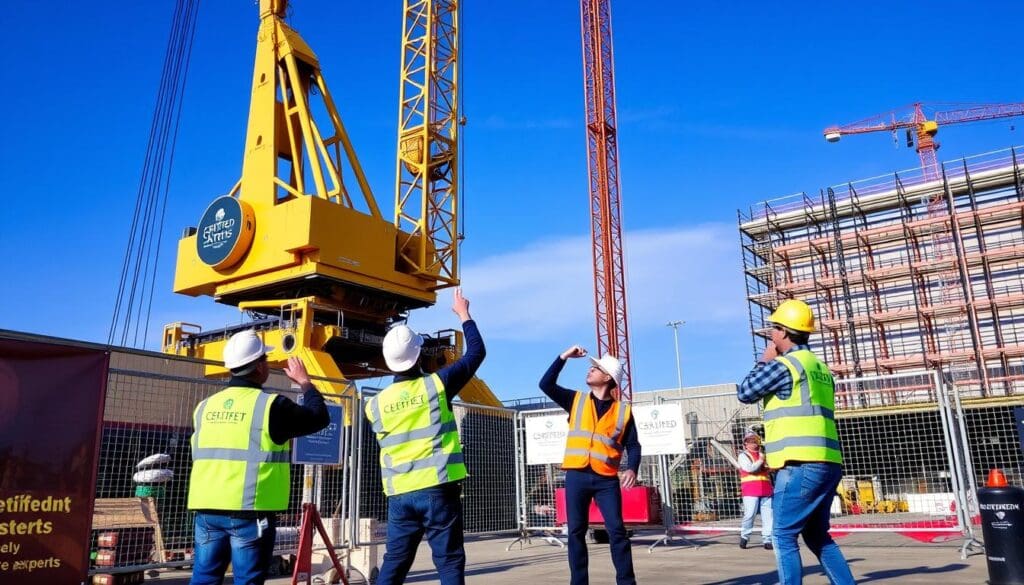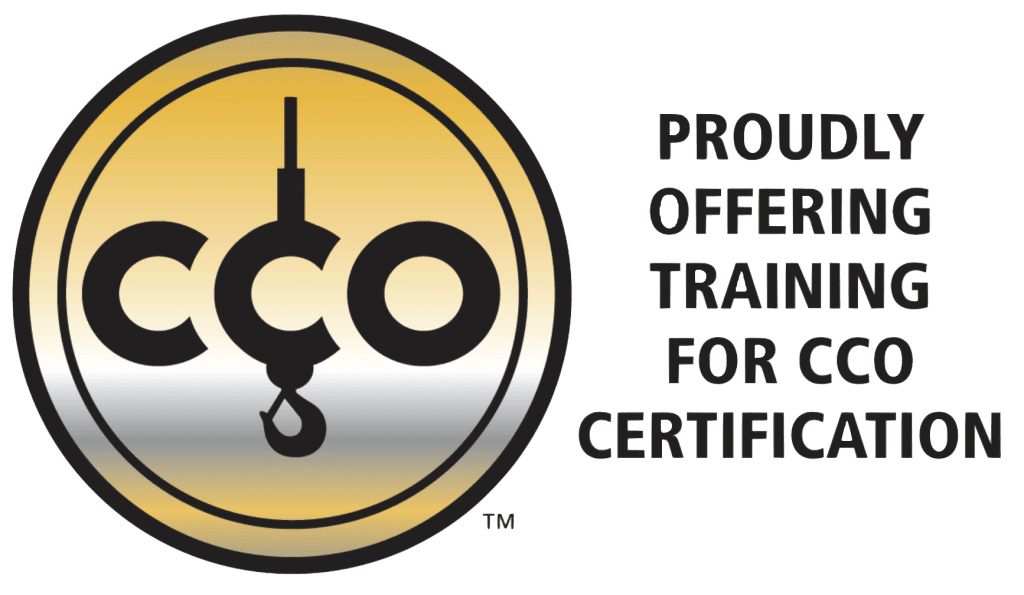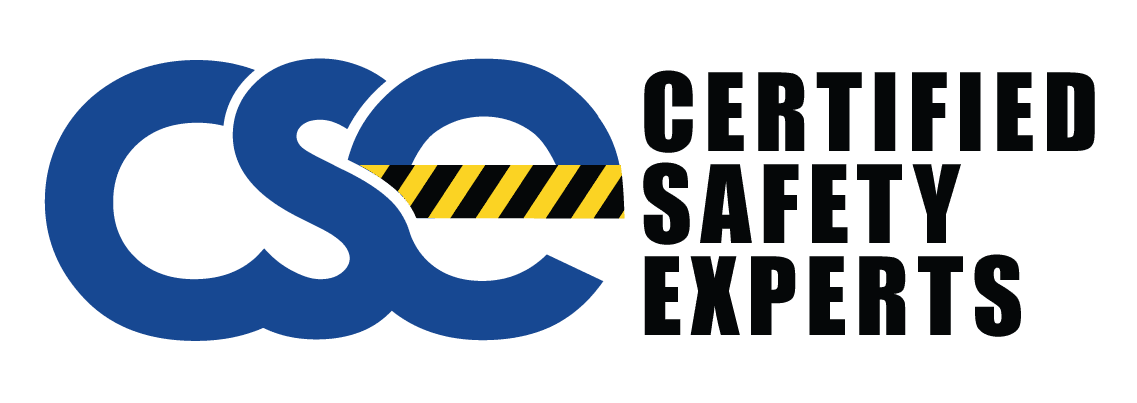Do you know the crane safety rules that make construction sites in the US safe? These rules, set by groups like the Occupational Safety and Health Administration (OSHA), are key to avoiding big problems. They’re not just about avoiding fines; they’re about saving lives.
In the construction world, following these rules keeps workers safe and buildings strong. It’s a matter of life and death.
Key Takeaways
- Understanding and complying with crane safety regulations is crucial for preventing accidents in the construction industry.
- Regulations set by OSHA and other authoritative bodies are essential for the well-being of construction personnel.
- Adhering to standards ensures the integrity and stability of structures being erected.
- Knowledge of these safety laws protects companies from hefty penalties and legal repercussions.
- Proper training and certification are mandatory for all crane operators to meet the safety criteria.
Overview of Crane Safety Regulations in the US
Cranes are key in many industries, but they need strict rules to be safe. In the US, crane safety laws have changed with new tech and industry needs. Lifting equipment guidelines are key to keeping people and property safe.
Under OSHA 29 CFR 1926 Subpart CC, there are clear crane safety rules across the country. These rules cover how to use, maintain, and check cranes. They stress the need to follow these rules to lower risks and dangers. OSHA’s guidelines match industry needs while putting worker safety first.
The ASME B30 standards give deep insights into using different cranes safely and efficiently. These standards are updated often to include new tech and ways of working. This shows the industry’s strong focus on safety.
The National Safety Council (NSC) is also key in promoting safety standards for cranes. It pushes for best practices and educational tools. This helps companies stick to safety rules. With efforts from groups like the NSC, crane safety gets a full look, covering laws and real-world use.
In summary, the US’s crane safety rules show how important clear guidelines and standards are. By following safety standards for cranes and lifting equipment, industries can work safer and more efficiently. This protects workers and assets.
OSHA Crane Regulations: What You Need to Know
OSHA crane regulations are key for keeping workplaces safe, especially with heavy equipment. The Occupational Safety and Health Administration (OSHA) sets clear standards for crane safety. These standards help ensure cranes are used safely and maintained properly.
OSHA Standards for Construction Cranes
For construction cranes, OSHA’s rules are found in Title 29 of the Code of Federal Regulations (CFR) Part 1926.1400. The main points include:
- Operator Qualifications: Operators must be certified by an accredited body or through an employer’s program.
- Equipment Certifications: Cranes must be checked before use and certified by a qualified person for safety.
- Safe Operating Procedures: Employers must set and follow specific rules for crane use, including handling loads and assessing hazards.
OSHA Standards for General Industry Cranes
General industry cranes follow OSHA 29 CFR 1910.179. These rules require:
- Operator Qualifications: Operators need proper training and qualification for crane operations.
- Equipment Certifications: Regular checks and certifications are needed to keep cranes safe.
- Adherence to Safety Procedures: Employers must have detailed safety plans, including maintenance and load handling.
Following OSHA crane regulations helps companies reduce risks and improve crane safety in construction and general industries.
Inspection and Maintenance: Key Requirements
Keeping cranes safe means following strict inspection and maintenance rules. Regular checks and upkeep keep them running safely and meet laws.
Cranes Inspection Checklists
It’s key to use good cranes inspection checklists for daily and regular checks. ANSI/ASME B30.2 and OSHA 29 CFR 1910.179(j) set clear guidelines. Important checklists include:
- Daily visual and operational checks
- Monthly detailed inspections of wire ropes, hooks, and brakes
- Annual thorough checks of structural parts and electrical systems
Scheduled Maintenance Procedures
Following the maintenance schedule from the maker is vital. Regular crane upkeep, like lubrication, replacing parts, and testing systems, stops sudden breakdowns. Companies should plan to:
- Do routine maintenance at set times
- Have periodic deep maintenance on high-wear parts
- Do full system checks to spot and fix issues early
Documentation and Record-Keeping
Good records and documentation are key for crane safety checks. They keep a record of all inspections, upkeep, and fixes. Important parts of documentation are:
- Keeping detailed logs of inspections and maintenance
- Recording dates, findings, and actions taken
- Keeping records easy to find for later use and to follow laws
Safe Crane Operation Protocols
Using strict crane operation protocols is key for safe crane use on any site. These rules help keep workers and property safe and follow industry laws.

First, operators must check the work area before lifting anything. They need to look at the ground, spot any dangers, and make sure the crane is stable.
When operating a crane, clear signals are a must. Hand signals and radio talks should follow set rules, as per OSHA 29 CFR 1926.1419-1430. It’s important that everyone knows these signals to avoid mix-ups and accidents.
- Pre-Operational Checks: Make sure all crane parts are working right before starting.
- Operational Protocols: Always follow load charts and don’t go over the crane’s limit.
- Post-Operational Procedures: Make sure the crane and loads are safely secured after use.
If there’s an emergency, act fast. Having a clear emergency plan, like the one from OSHA Fact Sheet – Crane Safety, is vital. This plan should cover quick evacuation, first aid, and alerting authorities.
Groups like the NCCCO stress the need for ongoing training and certification for crane operators. Keeping up with safe crane operation training keeps safety levels high.
By sticking to these crane operation protocols, construction sites can cut down on crane accidents. This makes the workplace safer for everyone.
Overhead Crane Safety Rules and Best Practices
Overhead cranes are key in many industries. It’s vital to follow safety rules to avoid accidents. This part covers important safety rules, checks before starting work, how to handle loads, and the need for trained operators.
Pre-Operations Safety Checks
Before using an overhead crane, it’s crucial to do safety checks. These checks include:
- Looking for any damage or wear on the crane.
- Checking that all controls work right.
- Making sure the area around the crane is clear.
- Checking that safety gear is working.
Doing these checks helps follow safety rules and lowers the risk of crane accidents.
Load Handling Guidelines
Handling loads right is key to keeping cranes stable and safe. Important rules are:
- Make sure the load doesn’t go over the crane’s limit.
- Secure the load so it doesn’t move during lifting.
- Use the right slings and rigging gear.
- Keep a clear view and talk with ground teams.
Following these guidelines is key to keeping a safe work area and following crane safety rules.
Operator Training and Certification
Training and certifying crane operators is crucial for safe use. Operators should learn from:
- ASME B30.2 standards for overhead and gantry cranes.
- OSHA Standard for Overhead and Gantry Cranes rules.
- CMAA Specification No. 78 guidelines.
Good training and certification make sure operators know the safety rules. This lowers the chance of accidents.
Ensuring Compliance with Crane Safety Laws
Following crane safety laws is key to a safe work environment and avoiding legal trouble. Companies must follow both federal and state rules to keep workers safe and operations smooth. Not following these rules can result in big fines and even stopping work.

Federal and State Regulations
Crane safety laws include many federal and state rules. The Occupational Safety and Health Administration (OSHA) sets guidelines to prevent accidents. States also have their own rules, often adding to federal guidelines for local needs. Companies need to keep up with changes in both federal and state laws to stay compliant.
Penalties for Non-Compliance
Not following crane safety laws can lead to big fines and business disruptions. It can also lead to legal action. The costs go beyond money, hurting a company’s reputation and possibly leading to losing licenses. Staying compliant is a legal and ethical duty that protects workers and reduces risks.
Businesses should get help from safety experts and do regular checks to make sure they follow all safety rules. For full services and to make sure your crane safety laws are met, call (919) 326-3742 today.
Conclusion
Following crane safety rules is more than just a law. It’s a key duty to protect workers and make construction sites run smoothly. Knowing OSHA standards well and keeping up with inspections and maintenance is vital. These steps are key to safe lifting and following the rules.
This article has shown how important it is to stick to federal and state safety laws. We talked about the right ways to use cranes safely and the rules for overhead crane safety. By following these rules closely, companies can avoid big fines and lower the risks of crane accidents.
It’s time to make safety a top priority in your work. For expert advice on crane safety, call us at (919) 326-3742. Making sure to inspect carefully, follow operation rules, and stick to all safety laws will keep your workers safe. It will also make your operations more efficient.




